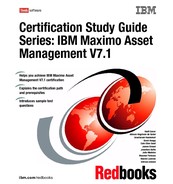24 Certification Study Guide Series: IBM Maximo Asset Management V7.1 A meter group is a set of meters that you can apply to an asset record. In the case of a rotating item, IBM Maximo Asset Management automatically applies any meter group that is associated with the rotating item to any assets that are created for that item. For example, a pump is a rotating item. On a pump, you might track meters such as inlet pressure, outlet pressure, and vibrations. These meters are common to all pumps. Instead of having to add these meters to each asset record created for this rotating item, you may instead create a meter group with this collection of pump- related meters and associate it with the rotating item. Each time you create an asset record for the pump, IBM Maximo Asset Management associates the meter group and its meters to the asset record so that you do not have to do it manually. 2.3.2 Condition Monitoring The Condition Monitoring application is used to create and view measurement point records for your assets and locations. A measurement point record defines the limits of acceptable meter readings for a characteristic or gauge type meter on an asset or location. You can generate preventive maintenance ( PM) work orders or work orders with a specific job plan for assets or locations whose meter readings are outside acceptable limits. Each measurement point is unique. You can compare similar measurement points on different assets or locations using meter readings. For example, you may use similar types of compressors in multiple locations, but you might have purchased the compressors from different vendors. If you have a pressure gauge on each of those compressors, you can generate reports that enable you to compare the pressure readings on those compressors. This information helps you to determine whether the compressors from one vendor are more efficient than a similar compressor from another vendor. You may not use a meter name more than once on an asset or location record, but you may use the same meter name on multiple asset and location records. Condition Monitoring tab is shown in Figure 2- 13 on page 24. : Figure 2- 13 Condition Monitoring application main fields
Chapter 2. Assets 25 Within those fields, you specify the Point of the monitoring condition by providing the asset name, meter to be monitored, its site, meter type, and the unit of measure. Then, you have to specify the range by setting the Upper Limits and the Lower Limits as shown in Figure 2- 14 and in Figure 2- 15, respectively. Figure 2- 14 Upper Limits section under Condition Monitoring application Figure 2- 15 Lower Limits section under Condition Monitoring application All measurements can be entered as part of a work order rather than directly against the measure point record in the Condition Monitoring application. When this is the case, a better approach is to set up a cron task to automate the generation of the work order when the limits have been exceeded. Initially set the schedule on the cron task instance to run every 10 minutes. If you use an existing instance, check the OrgID and SiteID cron task parameters. To verify whether the cron task has been run, review the Cron Task History after the specified time. If the last measurement has exceeded its action limits, you will find that a work order was generated. There are two main differences between measurement points for characteristics meters and for continuous meters. When an upper or lower limit exceeds its limit for a characteristics meter, a preventive maintenance ( PM) item is generated.
